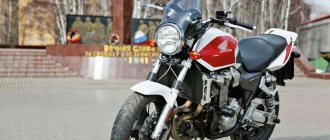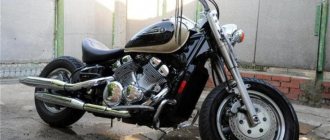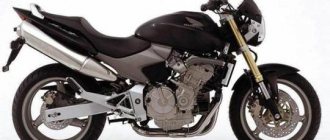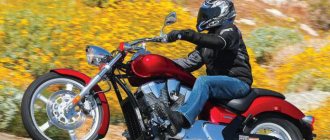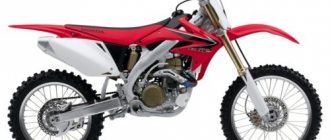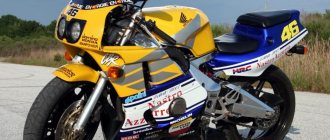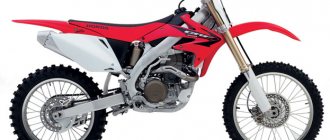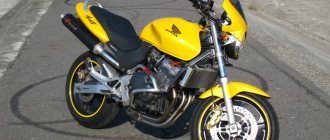Everyone knows that in addition to producing cars, the Japanese company Honda places great emphasis on the development of motorcycles. Therefore, the range of motorcycles of the corresponding brand is rich in sports and road bikes. Some models of two-wheeled vehicles from Honda generally manage to combine classic design and innovative technologies. Take, for example, the Honda cb 1300 motorcycle, which has long been the company’s flagship
Release Features
Honda CB1300SF 1998-2002.
Honda CB1300SF 2003+.
Following this concept, of the naked bike began 1998 . Seven years later, a model with a front fairing appears. Like the 400, the modifications are respectively named Super Four and Boldor .
Production of both versions continues. Over its 20-year history, the bike has gone through one generation.
In addition, some cosmetic changes are made almost every year. The filling basically remains the same.
The position of marketers regarding generations is curious. The first is to sell only in Japan. The following is also for export. It is noteworthy that North America (USA and neighboring countries) is missing from foreign markets.
The motorcycle pleases with excellent dynamics, excellent handling and amazing versatility.
Since the model is still in development, a Russian user, if he is not bothered by delivery from abroad, can order a brand new Sibikha for an amount starting from $7,000 . And since the production of the bike did not start yesterday, there are options on the secondary market. The cost of a model with mileage in the Russian Federation starts from 150 thousand rubles , without - $3,500 and above.
Specifications
| Honda CB1300SF | Parameter |
| Years of manufacture | 1998-2002 |
| Type | classic (road) |
| Engine | 1284 cm3, 100 hp, 4-cylinder, 4-stroke liquid-cooled in-line engine |
| Petrol | 92-95 |
| Transmission | 5-speed manual transmission, multi-disc, oil bath |
| Drive unit | chain (chain) |
| Fuel supply | no fuel pump, low pressure |
| Front tire | 130/70ZR17 (62W) |
| Rear tire | 190/60ZR (78W) |
| Tank capacity | 21 liter |
| Distance on one tank | ~ 300 km |
| Maximum speed, km/h | 240 km/h (180 km/h Japanese market) |
| Acceleration up to 100 km/h | 3.5 sec |
| Length, mm | 2 200 |
| Width, mm | 780 |
| Height, mm | 1 165 |
| Wheelbase, mm | 1 545 |
| Ground clearance, mm | 130 |
To start production, engineers take the engine from the Honda X4 (CB 1300DC), which was launched several years ago. The engine shows good performance, so they decided to use it on the Sibikh in the first years of production.
With a generation change, in 2003, the carburetor changes to an injector, and the ignition becomes transistorized.
First generation – carburetor, 4x Keihin 36 mm.
Second generation - injector, PGM-FI.
A redesigned exhaust system reduces fuel consumption. In light of this, instead of a pair of mufflers, only one is being installed. But fundamentally the engine does not change - it is a 4-cylinder, 4-stroke liquid-cooled engine with in-line pistons .
Users noted that it works well and does not require 95 gasoline.
Transmission and clutch
For a long time, the motorcycle was equipped with a 5-speed gearbox. Only in 2014, with the next restyling, the model received a 6-speed gearbox.
The owners note that everything works smoothly, the desired gear is engaged without questions, neutral is located immediately.
The main drive is standard - chain . But the clutch is hydraulic .
Chain drive.
Front brakes.
Rear brakes.
Brakes
According to user reviews, the brakes on the bike are quite good.
- The equipment is standard - 2 discs in the front, 1 in the rear.
- Rotor diameter - 310/276 mm .
- When the generation changed, changes affected the front support bracket. If previously a 6-piston engine , then they began to use 4 pistons . The rear bracket is normal - 1 piston .
Since 2005, ABS has appeared , but it is not included in the stock configuration - it is an option . The user is left with a choice - to bet on 2 wheels or any one.
Motorcycle history
The premiere of the Honda CB 1300 took place in 1997 as part of the Tokyo Motor Show. Then company representatives said that their new brainchild was intended to take the baton from the HondaCB 1000. And now, a year later, Honda officially announces the start of production of the “one thousand three hundredth” motorcycle.
cb1300
At the same time, the main percentage of Honda cb1300 sales was intended to affect the Japanese market. The situation changed only in 2003: the hero of the theme, updated to the 2nd generation, “emigrated” to Europe, Asia, Oceania and even South America. The North American market was much less fortunate, because officially it never “expanded” the Honda SB1300.
Modifications
Honda CB1300 SB – modification with a semi-fairing.
Honda CB1300 ST – tourist modification.
Unlike the legend, the bike received 3 modifications.
- Honda CB1300SF (Super Four) is a classic naked bike, launched in 1998 and still being built.
- Honda CB1300SB (Super Bold'Or) - the presence of a semi-fairing, square headlight, windshield, as well as symbolic glove compartments on the dashboard distinguish this version. Starts in 2005, production continues.
- Honda CB1300ST (Super Touring) is a touring option. In stock combi-brakes + ABS, side cases of 29 liters each. It differs from the equipment of Boldora in that it has a less powerful motor, but an improved generator. Started in 2010, closed in 2014.
Honda CB1300 Super Four: 1284 cm3, 115 hp, 224 kg, $9500
Vertical racing... It was under this unspoken motto that the late 90s of the last century took place for the largest motorcycle manufacturers. There was a rapid expansion of model ranges, capacity increased, motorcycles became more and more perfect. Honda at that time had only one lag behind its competitors - in the segment of large classics. At a time when Suzuki, Kawasaki and Yamaha had long been sporting 1200 or 1300 cc developments, concern No. 1 had only a liter modification in its arsenal. The error was corrected only at the end of 1998, when the CB1300 Super Four was released for the Japanese market.
The device, in fact, is an evolution of the well-known Big 1. It was its unpretentious and super-reliable engine that was taken as the basis - the cylinders were bored out, the carburetor power system and intake were modernized. As a result, we received a slight increase in power (100 hp) and maximum torque - 122 Nm at 5000 rpm. The classic layout of the components also implied a traditional type of chassis. The engine was enclosed in a steel duplex frame, the rear swingarm was made of aluminum alloy. But it was not without its quirks - the design of the rear suspension, in which the progressive characteristics were determined by not one, but two Showa shock absorbers, is still considered very original and unusual.
The further track record of the CB1300 Super Four is not particularly remarkable. In 2000, the model underwent a slight modernization, and in 2002 it was finally introduced to the European market. The second generation CB1300 received fuel injection and a traditional classic rear suspension with two backpack-type shock absorbers. In the same year, the Japanese version of Super Four also acquired these innovations. Improvements have led to the fact that the model has become not only more powerful (115 hp), but also significantly lighter (224 kg versus 246 kg). The wheelbase has also decreased. If at first the CB1300 Super Four was not in particular demand in the domestic market (in fact, this fact explains the delay in the decision on its debut in Europe), then since 2001 the “big seabird” has become almost in great demand. Refined ergonomics, an indestructible engine, a classic, timeless appearance - these are the components of successful promotion on the market. The release of the CB1300 II only added fuel to the fire. Its sales rating in Europe has surpassed even such eternal bestsellers as the Suzuki Bandit 1200 and Yamaha XJR1300. The Super Bol d'Or modification with a semi-fairing in the spirit of the GP of the 70s and 80s, which debuted in 2005, was intended to consolidate the success. At the same time, the list of options was also supplemented with ABS.
The Japanese themselves classify this motorcycle as eternal. It will be present in the company’s lineup for at least another five years without any upgrades. At the same time, the CB1300 Super Four does not require any hassle in terms of repairs. Isn’t this the kind of motorcycle many people dream of? But the other side of the coin is the price. For a wonderful bouquet of characteristics you have to shell out a lot of money. What is its fate on the Russian market, where powerful multi-cube machines have always been loved?
Vladimir Zdorov, Motor Review expert Height – 193 cm, driving experience – 13 years, rides a BMW K1200R “Real” and “correct” motorcycles have almost no vulgar plastic and vulgar fairings with flirty rectangular eyes-headlights enclosed in them. The steering wheel will never force the owner to bend even a little when landing (not solidly, you know...), and the size of the seat is ready to accommodate at least three people. This is a real classic. Almost any motorcycle manufacturer must produce such models. After all, classics, no matter whether we are talking about music or motorcycles, always remain in demand - they are timeless.
The Honda CB1300 is one such motorcycle. All the signs of the genre are present here. “Two glasses” of the dashboard, convenient rear-view mirrors, naturally round in shape, an ordinary front telescope... A steel frame, a rear swingarm, not very different in shape from models of 50 years ago, and two rear shock absorbers are a sure sign that handling is sacrificed here for economy. On the other hand, it’s no different with classics; the point here is not so much about savings as about the established approach to the production of such motorcycles. True, the liquid cooling of the engine, which is larger in volume than some small cars, stands out a little from the general outline, but you can always be calm about its thermal conditions.
In many ways, the perception of such a motorcycle depends on the mood and road conditions prevailing at the time of the test. Let's say, you got into Friday traffic, where the decisive factor in helping you escape from the concrete embrace of city streets teeming with hordes of cars is sometimes even the extra five kilograms of weight and ten millimeters of base - consider it negative. The same motorcycle, but on a country trip, easily eating up the unevenness of the Moscow region, on which sometimes another asphalt enduro can “choke” - a completely different situation...
But all these are emotions, although a motorcycle, like no other vehicle, is chosen precisely for the opportunity to receive these very emotions, turning a blind eye to the shortcomings for which automakers would easily go bankrupt! Despite the relatively modest 115 hp for such an engine size, the SV1300, without straining, allows you to perform a standard set of hooligan antics, which I call a mandatory program, although I suspect that future buyers of this motorcycle are the least concerned about such moments. True, if you start to abuse it, then, even despite all its legendary reliability, Honda will definitely “fall apart,” and very soon. What I mean? Well, let’s say, when performing a wheelie, which by the way is only possible in first gear, on landing there is almost always a mandatory breakdown of the front fork, accompanied by a dull thump in the area of the steering bearing.
When trying to aggressively corner, the footrest stops begin to complain of life, and there it is very close to the muffler... At the same time, no miracles happen - the frame is steel, so the motorcycle swings more than unequivocally, which sooner or later will certainly lead to the corresponding results... The only thing , where Honda is absolutely not inferior to its most modern classmates is in cannon acceleration, especially up to the first 100 km/h. Although, no, I’m wrong here. The assets also include calming comfort, an almost complete absence of vibrations, a large (21 l) gas tank and... a very humane price list, in a word, the classic offer - “a lot of motorcycle for relatively little money.”
But the format of this leviathan, despite its Japanese origin, is designed for fairly large male individuals; after all, 250 kg of curb weight in combination with a 1515 mm wheelbase are not the most “friendly” indicators... Even after the by no means the lightest BMW K1200 R, SV1300 It is perceived exactly as a heavy motorcycle. But no one tried to pass it off as a nimble “six hundred”. Everything here is really big, be it engine capacity or weight - a real masculine machine. But I don't need one like that. Rough, undisguised power, not supported by appropriate handling, brakes that turn sour after two or three sharp braking after 200 km/h, the inability to “tastefully”, at the limit, “eat” some interesting turn.
Not everything is going well in the city either; with such dimensions, given the density of traffic, it’s not easy. But it’s also worth noting that the 1300 cc engine has indecently swollen side “cheeks” - they will certainly suffer if they come into contact with asphalt, so the protective arches are a necessity here. And with them, the already decent overall width will only increase. But all these shortcomings are obvious from the position of a “plastic” adrenaline seeker and are not at all critical for those who need a motorcycle not for fine walking at the limits of the capabilities of both the equipment and themselves, but for simple two-wheeled happiness, measured not only by the parameters of the front departure angle forks or an unprecedentedly low weight, but also that feeling of freedom that only a motorcycle can give. And with this, the Honda CB1300 is just in perfect order!
Nikolay Bogomolov, Motor Review expert Height - 183 cm, driving experience - 8 years, rides a Honda CRF450R The appearance of the motorcycle suggests that it is designed to move in a straight line. It's not even about the archaic rear shock absorbers, the simple “telescope” and the steel frame. The gigantic engine, which is not covered by anything, makes the motorcycle so visually heavier that when you find out the real weight, you are even surprised at its insignificance. However, on a crowded road it immediately makes itself felt. It feels like riding a heavy chopper, except that the landing is straight. But if you get used to it, slalom between cars can be fun.
The driver's comfort here is exemplary; not every tourer can boast of this. This feels especially good on an empty road. The body is in a natural position, all controls are easily accessible. The CB1300 is one of those rare motorcycles on which, due to the complete absence of fairings, headwinds do not particularly bother the rider. Of course, at speeds above 200 you feel discomfort, but in general the wind protection is better than most of its classmates. The suspension is tuned for maximum comfort and does not break even on serious potholes. My favorite test, fast driving along tram tracks, the motorcycle passed “excellent”.
But the main reason for the extraordinary comfort is the amazing engine. It works so quietly that sometimes it seems that the motorcycle is not running. However, this feeling goes away as soon as you unscrew the throttle. There is no loud growl coming from the muffler, and vibrations do not shake the body. The engine still runs quietly. But at the same time, the motorcycle shoots no worse than many more powerful classmates. At the same time, the feeling of speed is dulled. If there was a fairing, the speed could only be determined by the speedometer. And a wind blower helps you navigate. However, all of the above advantages will look like disadvantages for many. Like other “super trucks”, from “four hundred” to “liter”, the CB1300 is a typical pensioner motorcycle. Even a powerful engine cannot save you: its performance is uniform to the point of disgrace. Yes, he pulls well from the bottom and carries at the top. But still, a motorcycle engine must have character. It allows you to move quickly, but you don’t get pleasure from such movement.
Moreover, the comfortable chassis is not suitable for racing. Soft suspensions sway during active maneuvering, like semolina porridge in a cook's ladle from a school cafeteria. The prehistoric frame and swingarm also can’t be called a street racer’s dream. But the brakes turned out to be the main limiting factor: despite their rather solid appearance, after five minutes of fast driving in traffic, I discovered that their already not very high efficiency had noticeably decreased. Accordingly, the braking distance has increased by the same amount. After a short smoke break, the mechanism started working as before, but the desire to rev the gas disappeared. In a word, for some the CB1300 will be a dream motorcycle, for others it will be the embodiment of all the worst that the modern motorcycle industry has produced. The truth probably lies somewhere in the middle. But I would advise all potential buyers to take a preliminary test drive. It's a very peculiar thing.
Mikhail Lapshin, Deputy Editor-in-Chief of Motor Review Height – 193 cm, driving experience – 13 years, rides a Yamaha TDM900 Probably, age is taking its toll. I remember that about five years ago the sighs of my adult comrades in the big classics caused only an internal grin, but now... Yes, now I can understand them, there is something special in this white and red pile of iron. Thoughts about retirement, an apple orchard and a bunch of grandchildren fussing in your arms immediately begin to flash through your head. This is probably the kind of motorcycle that an older motorcyclist should have in his garage. It’s like a bank bill, like a smart investment of money - seriously and for a long time...
But prose is prose, and life dictates its own. I received a sharp thorn in my heart on Observation Street when I parked a CB1300 in the rows of “plastic rockets” and “streets”. I haven’t seen such indifference to a car for a long time. Even the YBR125 received more attention. The neighboring motorcyclists glanced at my device, then at me and turned away. And at that moment I felt like a real old fart. Meanwhile, my soul was filled with impressions from the car, which she had already more than given me, while I was driving the motorcycle from the showroom to Vorobyovy Gory.
The CB1300 required no “acclimatization” at all. Still, Honda's ergonomics are simply superb. In particular, the Seabikha has an excellent saddle, and the steering wheel is conveniently located. With my rather big legs, the high and wide saddle and the large-sized gas tank came in very handy - I grabbed it and immediately felt that this was a real motorcycle. In a crowded street, you can easily crawl at a snail's pace in second gear, fortunately, the elasticity of the engine is such that it is just right to lend. It is from the second gear that you can easily accelerate from a traffic light and do everything and everyone. Of course, if your opponents are not such a seasoned sport biker as Zdorov. And the dimensions, in principle, allow you to fit between cars quite confidently. But it’s not easy to move almost a quarter of a ton from side to side. But the higher the speed, the easier it is. But in the operational space you can turn around and enjoy the frantic temperament of the engine. 115 “horses”, coupled with a gearbox perfectly matched to gear ratios, allow for hooligan antics. And you can’t say about the brakes that they saved money on them. In city traffic and when driving at speeds up to 150 km/h, their grip is 100% sufficient. But if you “shoot” at 200 km/h (the device can allow even more!), then you need to remember that a couple of sharp decelerations can send the pads “swimming”. However, branded components and reinforced lines can solve this problem.
When I had a 1200 cc “bandit”, traveling with a passenger was a real pain. Firstly, the footrests were inconveniently high, and secondly, the slope of the pillow was such that the “second number” constantly strove to take my place. Here, these moments are in complete order. The passenger kept asking me over my shoulder in surprise: “Are we going 180?” I admit that your humble servant even forgot about this “ballast” several times. The shape of the “tail” also allows you to place an impressive luggage case or bags for long-distance travel. A nice bonus to the standard 13-liter glove box under the saddle.
But the standard light optics no longer fit modern standards. It is clear that the “round headlight” design is forever, but for motorists who only notice something unconventional and xenon in the mirrors, this moment can play a cruel joke. Especially in the dark.
Another obvious disadvantage of the car is the softness of the front fork. They say that a more viscous liquid cures this “sore”. Let's hope... It's probably not worth talking about the fact that the device is not very confident in cornering, requires body work and is prone to tearing off the rear wheel at critical inclinations. This is the norm for its class, and I think that the CB1300 can give a head start to modern neoclassics in many qualities. So my verdict is the following: the motorcycle is excellent, perfect for those who choose a device based on the principles of “lots of motorcycles” or “seriously and for a long time.”
Alexander Astapov, Deputy Editor-in-Chief of Motor Review Height – 182 cm, driving experience – 15 years, drives an Italjet Dragster XX “I need pills for greed, more, more!” A big bike in general and this “Seabix” in particular is the limit of desire for an ex-rocker, nostalgic for his favorite “Chezet” and at the same time not too wealthy to fork out for a Ducati GT. And what? One or three liters for that kind of money is a very good investment. At first sight. Yes, and the second one too. A stern (I almost said “masculine”) appearance without unnecessary decor, two chrome-plated dashboard glasses, “casting”, disc brakes - an excellent reason to remember the scenes from films “about not our lives” seen in childhood. Films where unprecedented motorcycles flashed every now and then, “falling over two hundred”, the coolest of which were - we knew that for sure then! - Honda brand. But times have changed, we learned different words: Ducati, Triumph, Yamaha... And the motorcycles themselves are already different. Let's look at the childhood dream - or rather, its modern embodiment - with an open mind.
Ick... tha... we need to warn you! A quarter of a ton of weight, not chopper ones, but “normal” ones, with a by no means low center of gravity, almost hit the asphalt. Hmm, I remember that the heavier (and fully packed!) R1200 RT was much easier to move in the parking lot. A couple of minutes later I remember the journalistic cliche, worn out to the point of hysterical laughter, “however, as soon as you start moving, these kilograms magically disappear.” Yes, they don’t disappear anywhere here! This load on the muscles is reduced due to the gyroscopic effect - although you have to work your biceps in any way. But you always remember that there is a heavy iron carcass under you, at every lane change, at every turn.
Such a weighty moment of inertia is excusable for a tourer, and even more so for a cruiser. But under me is not a device for specific use far outside the city or on a night avenue, but a universal motorcycle, according to that old classification. And if it’s universal, it means it’s designed for use on any roads (with hard surfaces, of course). And this is exactly the problem. In traffic jams you will get tired of tossing around with them. Wide, heavy, with a base like a chopper - yes, I saw your name day in a coffin! Outside the city, there is nowhere to appreciate the benefits of the flexible 115-horsepower engine. You can accelerate in Varshavka, but up to a certain speed. After 180 the vehicle blows off, which is understandable; already at 140 the fork shows its spinelessness on wavy asphalt, and the frame, which is not rigid enough for such speeds, imposes serious speed restrictions. Burn off the rubber? Where? On sandy and cracked suburban asphalt? I’ll keep silent about the combination of turns: dynamic riding on them is not about this monument to the Classic Motorcycle, because you have to move the handlebars like a barbell in a “rocking chair”.
We can talk about excellent ergonomics, huge resource and other advantages of this model. But all this will be from the series “But we make rockets.” I agree, the advantages of this model compared to its competitors (the same Bandit 1200) are important. But only after you decide on the question: why do you need a big bike at all? During our acquaintance, I had the opportunity to be convinced once again: a universal thing is equally unsuitable for all occasions.
Although this is not the problem with big bikes, namely that they are too “big”. Neoclassicists of a smaller caliber have by no means exhausted themselves. Here, motorcycle companies, trying to satisfy the specific needs of a certain category, have taken the idea of a classic motorcycle to the point of absurdity. And the inexperienced, but highly ambitious buyer still looks at such an attractive price-displacement combination. Without thinking that for the same money he can buy a motorcycle, albeit less impressive from the outside, but giving much more real driving pleasure. Naturally, if you carefully formulate your requirements and driving preferences before purchasing. And the SV1300 does not meet my requirements. Well, I don’t have the need to become a cool macho man, sparkling with leather pants, a snow-white “drunk” T-shirt and tattooed biceps in front of club face control!
Motor review No. 10, 2006
and competitors
Competitors also presented their developments, while Suzuki distinguished itself with as many as 4 versions. What is curious is that all four belong to the class of road workers. This:
- GSF 1200 Bandit.
- GSF 1250 Bandit.
- GSX 1200 Inazuma.
- GSX 1400.
The rest were not so prolific and offered 1 motorcycle each:
- Kawasaki ZRX 1200;
- Yamaha XJR 1300.
Honda itself was thinking about putting out a dragster, which was mentioned just above, but abandoned the idea, citing the fact that for this it would have to be introduced to the world market, and it was created for itself - only for Japan .
Advantages and disadvantages of the Honda CB1300SF
Honda CB1300 SF is a “real” and “correct” motorcycle without plastic and rectangular headlights.
Since the developers sought to make a motorcycle as similar as possible to the legend, the model does not have many differences of its own.
- 2 springs on the pendulum.
- Posterior progression (before generation change).
- Hydraulic clutch drive.
- The seating position is classic , but there are complaints about the slipperiness of the seat, as well as the high footrests.
- The side stand is further away than it should be to install the bike comfortably.
- Good traction , while maintaining stability on a given trajectory.
- Excellent maneuverability, allowing you to maneuver easily in traffic jams.
Separately, users note simplicity, reliability and limitless tuning possibilities.
Chassis and brakes
The frame of the machine is made of steel, and the type is duplex. The wheels on this model are alloy, and the steering wheel is typical for the class. In general, the exterior looks impressive, no less catchy than many motorcycles with a much more modern look.
The rear suspension is pendulum and equipped with two shock absorbers. This is a completely typical solution for such a motorcycle. At the front there is a 43 mm telescopic fork. The rear brake is represented by a single-piston caliper and a 276 mm disc, and the front has four-piston calipers and a pair of 310 mm discs. Such a braking system should probably be sufficient at high speeds.
